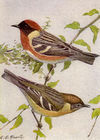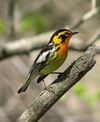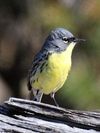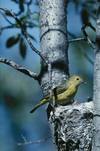Genus Dendroica

Adelaide's warbler - Dendroica adelaidae was originally considered a single species, D. adelaidae, with three populations occurring in Barbuda, Puerto Rico and St. Lucia. Each of these populations were regarded as a subspecies, Da.
Elfin-woods Warbler - Due to its small populations and restricted habitats, conservation efforts were begun in 1982 to protect this species but, as of 2005, the warbler was still in need of protection. The species is not in immediate danger as the majority of its habitat is protected forest, but introduced species, such as rats and Small Asian Mongooses, habitat reduction, and natural disasters represent potential threats to the population.
Black-throated Blue Warbler - Adult males have white underparts with black throat, face and flanks; the upperparts are deep blue; immature males are similar with upperparts more greenish. Females have olive-brown upperparts and light yellow underparts with darker wings and tail, a grey crown and a brown patch on the cheek. All birds have a small white wing patch which is not always visible, and a thin pointed bill. Like many warblers, this bird has colorful plumage during the spring and summer, but its fall plumage is drab and less distinctive. In the fall, it can still be identified from other similar warblers by its small white wing patch.
Bay-breasted Warbler - These birds are migratory, wintering in northwest South America and southern Central America. They are very rare vagrants to western Europe.
Cerulean Warbler - The Cerulean Warbler, Dendroica cerulea, is a small songbird of the New World warbler family.
Golden-cheeked wood warbler - Golden-cheeked warblers nest in ashe juniper and live oak trees in ravines and canyons. They use bark and spider webs to build their nests. Females lay three to four eggs. Warblers eat insects and spiders and the adult warbler can reach a length of 4.5 inches. They winter in southern Mexico , Guatemala, Honduras, and Nicaragua.
Yellow-rumped Warbler - Since 1973, American Ornithological Union has elected to merge these passerine birds as one species. The Myrtle and Audubon's forms were apparently separated by glaciation during the last ice age, and developed distinguishing physical characteristics. When it was shown, however, that they were able to interbreed, they were no longer considered as separate species. The two Middle American subspecies, goldmani and nigrifrons are sedentary and diverged from the northern migratory subspecies in the Pleistocene, and so probably represent separate species.
Prairie Warbler - These birds have yellow underparts with dark streaks on the flanks, and olive upperparts with rusty streaks on the back; they have a yellow line above the eye, a dark line through it, and a yellow spot below it. These birds have black legs, long tails, pale wing bars, and thin pointed bills. Coloring is duller in female and immatures.
Yellow-throated Warbler - In summer, male Yellow-throated Warblers display grey upperparts and wings, with double white wing bars. Their throats are yellow, and the remainder of their underparts are white, and are streaked with black on the flanks. Their heads are strongly patterned in black and white, with a long supercilium; the different subspecies may display yellow and white superciliums. Remiges and rectrices are black.
Blackburnian Warbler - The Blackburnian Warbler, Dendroica fusca , is a small New World warbler. They breed in eastern North America, from southern Canada, westwards to the southern Canadian Prairies, the Great Lakes region and New England, to North Carolina.
Grace's warbler - Grace's Warbler was discovered by Dr. Elliott Coues in the Rocky Mountains in 1864. Coues chose to name the new species after his 18-year-old sister, Grace Darling Coues, and his request was honored when Spencer Fullerton Baird described the species scientifically in 1865.
Kirtland's wood warbler - Kirtland's Warbler, Dendroica kirtlandii, is a small songbird of the New World warbler family , named after Jared P. Kirtland, an Ohio doctor and amateur naturalist. Nearly extinct just 50 years ago, it is well on its way to recovery. It requires large areas of dense young jack pine for its breeding habitat. This habitat was historically created by wildfire, but today is primarily created through the harvest of mature jack pine, and planting of jack pine seedlings.
Magnolia Warbler - The Magnolia Warbler, Dendroica magnolia , is a New World warbler. It breeds across most of Canada as well as New England and the Great Lakes region of the US.
Black-throated Grey Warbler - The Black-throated Gray Warbler is a songbird of the New World warbler family. It is 13 cm long and has black, grey, and white plumage. It breeds in western North America from British Columbia to New Mexico, and winters in Mexico and the southwestern United States. Common in in its forest habitats, it does not seem to be seriously threatened by human activities, unlike many migratory warblers.
Hermit Warbler - Mature Hermit Warblers normally grow to be 4½ to 5 inches long. Hermit Warblers are dark gray in coloration on top, and white below, and their flanks are streaked with black. The wings have two diagonal white wing bars. The majority of the Hermit Warbler's head is yellow, and males have a dark black throat, while females have much less black on their throat bib and immature birds have no black throat.
Palm Warbler - The species comprises two distinct subspecies that may merit specific status.
Chestnut-sided Warbler - These birds are migratory, wintering in Central America south to northern Colombia, with an unconfirmed sighting from as far south as Ecuador; they are also very rare vagrants to western Europe.
Yellow Warbler - Dendroica aestiva Dendroica aurocapilla Ridgway, 1887
Pine Warbler - The Pine Warbler, Dendroica pinus, is a small songbird of the New World warbler family.
Plumbeous Warbler - The Plumbeous Warbler is a species of bird in the Parulidae family. It is found only in Dominica and Guadeloupe. Its natural habitats are subtropical or tropical dry forests and subtropical or tropical moist lowland forests.
Blackpoll Warbler - These birds are migratory, wintering in northwestern South America. They are rare vagrants to western Europe, although their northerly range and long-distance migration make them one of the more frequent transatlantic passerine wanderers.
Barbuda warbler - The Barbuda Warbler is a species of bird in the Parulidae family. It is endemic to the island of Barbuda in Antigua and Barbuda. Its natural habitat is tropical dry shrubland near wetland areas. It is threatened by habitat loss.
Cape May Warbler - The summer male Cape May Warbler has a brown back, yellowish rump and dark brown crown. The underparts are yellow, streaked black, giving rise to the bird's scientific name. The throat and nape are bright yellow and the face is chestnut with a black eyestripe. There is a narrow white wing bar.
Townsend's warbler - These birds have a yellow face with a black stripe across their cheeks, a thin pointed bill, white wing bars, olive upperparts with black streaks on their backs and flanks, and a white belly. Adult males have a black cap, black throat and yellow lower breast; females have a dark cap and a yellow throat. Immature birds are similar to females with a dark green cap and cheeks.
Black-throated Green Warbler - It is 12 cm long and weighs 9 g, and has an olive-green crown, a yellow face with olive markings, a thin pointed bill, white wing bars, an olive-green back and pale underparts with black streaks on the flanks. Adult males have a black throat and upper breast; females have a pale throat and black markings on their breast.
Vitelline Warbler - It is found in the Cayman Islands and on the Swan Islands in Honduras. Its natural habitats are subtropical or tropical dry forests, subtropical or tropical dry shrubland, and urban areas. It is becoming rare due to habitat loss.























